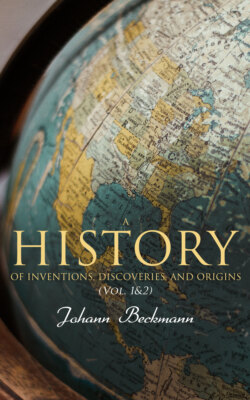Читать книгу A History of Inventions, Discoveries, and Origins (Vol. 1&2) - Johann Beckmann - Страница 12
На сайте Литреса книга снята с продажи.
ОглавлениеMACHINE FOR NOTING DOWN MUSIC.
Table of Contents
As I have occasionally mentioned in the preceding article, a machine for noting down any piece of music played on a harpsichord or other musical instrument, I shall here add a short history of the invention of it, as far as I know; and with the greater pleasure, as another nation has laid claim to it, though it belongs to my countrymen.
It appears incontestable, that a proposal for inventing such a machine was first made known by an Englishman. In the month of March 1747, John Freke transmitted to the Royal Society a paper written by a clergyman of the name of Creed, which was printed in the Philosophical Transactions under the following title:—A Demonstration of the possibility of making a machine that shall write extempore voluntaries, or other pieces of music, as fast as any master shall be able to play them upon an organ, harpsichord, &c.; and that in a character more natural and more intelligible, and more expressive of all the varieties those instruments are capable of exhibiting, than the character now in use27. The author of this paper however points out the possibility only of making such a machine, without giving directions how to construct it.
In the year 1745, John Frederic Unger, then land-bailiff and burgomaster of Einbec, and who is known by several learned works, fell upon the same invention without the smallest knowledge of the idea published in England. This invention however, owing to the variety of his occupations, he did not make known till the year 1752, when he transmitted a short account of it, accompanied with figures, to the Academy of Sciences at Berlin. The Academy highly approved of it, and it was soon celebrated in several gazettes, but a description of it was never printed.
A few days after Euler had read this paper of Unger’s before the Academy, M. Sulzer informed Hohlfeld of the invention, and advised him to exert his ingenuity in constructing such a machine. In two weeks this untaught mechanic, without having read Unger’s paper, and even without inspecting the figures, completed the machine, which Unger himself had not been able to execute through want of an artist capable of following his ideas.
Unger’s own description of his invention was printed, with copper-plates, at Brunswick, in the year 1774, together with the correspondence between him and Euler, and other documents. A description of Hohlfeld’s machine, illustrated with figures, was published after his death by Sulzer, in the new memoirs of the Academy of Berlin, 1771, under the title of ‘Description of a machine for noting down pieces of music as fast as they are played upon the harpsichord.’ Sulzer there remarks, that Hohlfeld had not followed the plan sketched out by Unger, and that the two machines differed in this—that Unger’s formed one piece with the harpsichord, while that of Hohlfeld could be applied to any harpsichord whatever.
When Dr. Burney visited Berlin, he was made acquainted with Hohlfeld’s machine by M. Marpurg; and has been so ungenerous, or rather unjust, as to say in his Musical Travels, that it is an English invention, and that it had been before fully described in the Philosophical Transactions. This falsehood M. Unger has sufficiently refuted. Without repeating his proofs, I shall here content myself with quoting his own words, in the following passage:—“How can Burney wish to deprive our ingenious Hohlfeld of the honour of being the sole author of that invention, and to make an Englishman share it with him, because our German happened to execute successfully what his countryman Creed only suggested? Such an attempt is as unjust in its consequences as it is dishonourable to the English nation and the English artists. When we reflect on the high estimation in which music is held in England, the liberality of the English nobility, and their readiness to spare no expenses in bringing forward any useful invention, a property peculiar to the English, it affords just matter of surprise that the English artists should have suffered themselves to be anticipated by a German journeyman lace-maker. To our Hohlfeld, therefore, will incontestably remain the lasting honour of having executed a German invention; and the Germans may contentedly wait to see whether Burney will find an English mechanic capable of constructing this machine, from the information given by his countryman Creed.”
FOOTNOTES
27 Phil. Trans. vol. xliv. p. ii. No. 483, p. 446.
